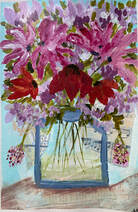 I love music, I have an eclectic taste in music which I was able to indulge in for 10 years as a radio show producer and presenter. I could pick and choose what to listen to in between the on-air interviews. You now have access to any song, genre and artist and thousands of podcasts with apps such as Spotify, Apple Music, Iheartradio and the like. I have also had two successful podcasts in the past both interviewing guests and sharing knowledge from LBA (life before art). You can probably tell I love sound and can be highly auditory given the nature of my past exploits. For me creating art is intensifying my visual skills and has reduced the need for auditory stimulation. Initially when I started creating again, I sat in silence and got lost in the paints. It was so relaxing and peaceful. It was also at a time that there was a lot of negativity and sadness in the world with the pandemic. Over the years I transitioned to a playlist for creating. It is easy to listen to and has intermittent songs I can hum or sing along to. I know of many artists that prefer to paint and create listening to music from various genres such as classical, heavy metal to easy listening. Occasionally I listen to a podcast from my favourite art podcasts such as Art to Life, Art Chatter and my all-time favorite Art Juice. Lately, I have opted for silence. I have been enjoying creating florals and being present in the moment of creating in silence. The stresses of everyday life slip away as the paint glides on, and time gets lost. What a fabulous feeling. Do you prefer music, podcasts or silence when you are working? What is your favourite podcast or music?
4 Comments
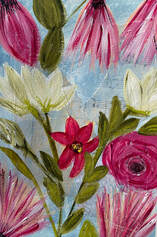 I remember when I entered my first art show and saw my work in a real gallery I was thrilled to bits. It was exciting and I made it happen. I bit the bullet and applied to have my artwork accepted. From that one piece being accepted I mustered up enough courage to approach a gallery to see if I could add some pieces on consignment. Yes, I was naive, but if you don't give it a go you will never know. In June 2023 I decided I wanted to exhibit some of my work, I had no idea how I would do this until the light bulb illuminated and I thought, why not have my own exhibition. I was totally unprepared for how much work this would take and what I needed to do to make it successful. In July, I ran my first open studio and art sale. It was harrowing to put myself "out there" even though I held it at home in our expansive patio now named "Art in the Garden Room". Would anyone turn up, what would they think of my artwork, will it be successful, what if it is too cold, too hot, too this, to that? Pushing through self-doubt with anything in your life is hard, I believe not trying is a harder pill to swallow. You can't sit around waiting for a knock on your door or the phone to ring. Instead, make your own luck, you never know what exciting things will happen. By the way, I have another open studio in November over a night and a day because, people turned up, it was a freezing cold wet day and they still came, I sold artwork and had an absolute ball. I learnt from it and hope the next one is bigger and better. Oh, is that a knock on the door? 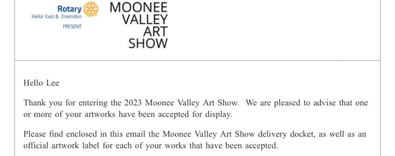 In July 2022 I entered my first art show. It was an amazing experience to go through the process of putting together the requirements for the online application. I was as nervous as a kitten. I didn't know what I was doing, what some of the questions meant or what I was supposed to write. Would my artwork stack up with other entries, was my work worthy of being accepted? Am I an imposter? All the questions came bounding up to me as I sat there with the computer screen in front of me and the online form bouncing from the screen and the questions swirling in my head. I took a deep breath and thought, what is the best thing that can happen? So, I entered my first art show, was accepted, and sold my painting. Not bad for a first time attempt. There are so many great reasons to enter art shows and art competitions. I find one of the most important processes to come out of entering is being able to explain your work. It gives you a chance to consider the piece you are entering, what is the emotion you are trying to evoke, what you were thinking, how does it relate to the show if it has a theme. I remember another show, the piece had to have D hooks. I had no idea what a D hook was or how I was going to fix it to my piece as I was entering artwork on a board which was only 3mm thick. After countless YouTube videos, practice on scrap boards I devised a solution. How do you pack a painting to go via post to an art show or exhibition? This was another hurdle I needed to overcome. I needed to protect my piece, the corners, the canvas, what is the best way of packaging? In the past I did not have to deal with postage as my art sales had been local and drop offs. All these little nuances prepare you for sales, speaking about your art and allow you an experieince to prepare you for future sales and exhibitions. Next time you see an art show advertised, give it a go and if you happen to be attending one, keep an eye out for me.  A few years ago, our spa decided it no longer wanted to work, so we bit the bullet and got rid of it. We were left with a cement slab and a spa fence, a perfect size for a small shed. Soon the shed was filled with art supplies, an easel, desk and makeshift lights. Prior to this I would create my art in our patio, on our kitchen table and out in the garden. Really, you can create in any space, yes, it is a pain to have to load and unload your supplies each time you want to create. Whether you ahve dedicated space, makeshift space, big space, little space you can create with whatever space you have available. Soon after I set up my little art shed, I had a commission to do and the canvas was much larger than I had worked on before. The art shed, which was only a few weeks old was too small! So, I moved my easel and supplies back into the patio and worked on the commission. My point being, no place will be 100% perfect so use what you have and create where and when you can. Enjoy the process. 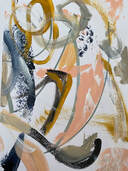 At first, I just didn't get why you would have an art journal or sketchbook. I thought what a waste of time, why not create directly onto your paper or canvas etc. Then........ I did a sketchbook course and that completely changed my thinking. I now have a few sketchbooks on the go, some I made during my Creative Circle program earlier this year. I also ahve a couple of sketchbooks in different orientations and spiral bound and hard bound. These books have been invaluable to me and my artwork. I use them for experimentation of colours, mark making, new supplies and ideas. If I happen to do a course, I use a sketchbook to document my learnings. If an idea comes to me, I put it into my sketch book. One of my favourite things to do in creating art is to colour mix so I use it to swatch colours and experiment with different palettes. Recently, I was working on a piece and knew it needed something, there was a little something that was missing. I flicked through a couple of sketchbooks and voila, there was my answer with one of my mark making experiments. It is just what was needed to bring the piece to life. Of course, when you are out and about a small sketchbook, a couple of pencils and even a small watercolour set is a great way to capture a moment in time. 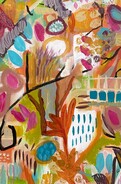 I started off painting on small canvas squares and art panels for a year or two. I then moved on to boards. I love using the boards particularly for some of my abstract work. You can scratch into the panels without fear of damaging a canvas. You can throw ink at it, spray water over it, sand it back and be rough on it. Boards are great but they have their limitations too, such as framing and weight. I move between boards, paper and canvas. When I am starting a piece, I think about the end result and that will determine the substrate. Each has their own unique benefits. I love working on paper, it is easy to use, affordable, easy to frame and easy to store. You can't be as heavy handed on paper, but it does have many benefits. The artwork pictured; Hidden Gem I used mixed media paper. I enjoy working on canvas and tend to find I use a canvas once I have completed a few paper pieces in the same colours or style. I feel freer to go about the piece having already played with the mediums, colours and mark making. When planning your next artwork, think about what mediums you will be using, do you need to sand back, scratch in, will you use lots of water or ink? These questions will help you determine the paper type, canvas or boards. 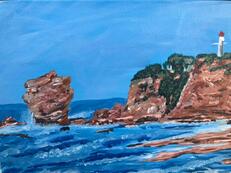 When I started back creating, I had nothing in my kit of supplies. Most of my creations of late had been on the computer in the form of social media posts and writing articles, eBooks and training manuals. I purchased two large canvases on sale and hubby came home with some paint brushes and paints. The paints were small tubes, the brushes were cheap and cheerful, but it was a start. I then purchased some small canvases 20cm x 20cm and artist boards 25cm x 20cm to practice on. Hubby and I spent hours painting and enjoying the process. I started off with student grade paints, and those cheap and cheerful brushes. By the way, it was weeks later we painted on the large canvas, after hours and hours of practice. If you plan to start dabbling in art for a hobby, start with what you have and what you can afford. Enjoy creating every day without worrying about wasting paint or messing up an expensive brush. Have fun and enjoy the moment. 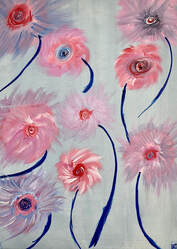 Don't you love it when you can sit back and enjoy the ride? Hubby and I have a caravan and we travel for a few weeks a year in it. He drives and I navigate but mostly sit back and enjoy the ride. We know where we are going and have no idea what will happen along the way. When I first went back into creating during 2020, I just played with the colours, played with the subjects and I had no expectation of how a painting would work out. I enjoyed the moment and got lost in the tranquility and fun of it all. I experimented with colour, brushes, techniques, and styles. I enjoyed the ride with no expectation. I believe art should be enjoyed, whether you are an observer, a professional artist with an art practice or it is your hobby. Mostly, art is for me enjoying the ride with no expectation. 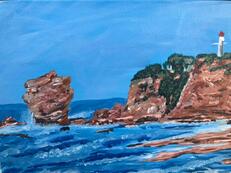 In 2020, the world as we know it changed, countries went into lockdown, cities ground to a halt and pollution almost disappeared. It was a challenging time for many and so many lives were lost. Business changed, the way we do business changed, schooling, social interaction and so much more all turned upside down. After years of running a business network for someone else, I branched out and in 2020, I was celebrating the one year opening of my network business. The first year we were thriving with 12 branches open in Victoria. Over the course of 2019 to 2022, the business had 24 branches open online and around Australia. Sadly, 2020 saw many businesses close and we changed how we did business. During 2020, I picked up my creative side again through acrylic painting. During the lockdowns it provided solace and head space to keep going whilst living in the most lockdown city in the world. I took online classes with some amazing international artists during this time and painted almost every day. I felt at peace, relaxed, and absorbed into a world of living with intention. As life went back to some level of normality I started taking face to face art classes and continued studying under some amazing international artists. One good thing that came from lockdowns was the access to world class training via the internet. I got a taste of how life could be easier and less stressful. In 2022 it was time for my full stop, from that day I knew life can be easier, life can be different, and I am going to change my future. Just making the decision to let go of my business in 2022 was a huge relief and one that allowed doors to open that I would never have imagined. It was the best decision I made just to let go. What can you let go of and what is it that stops you? |
AuthorLee Cummins is a mixed media artist, workshop and art class facilitator. Archives
July 2024
Categories
All
|

 RSS Feed
RSS Feed
